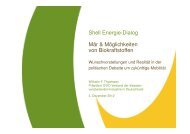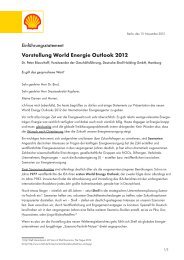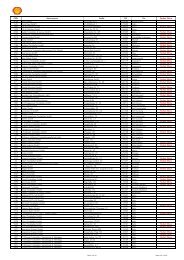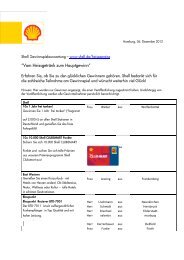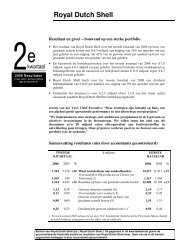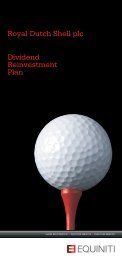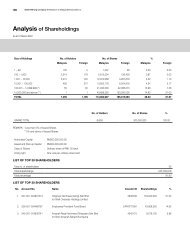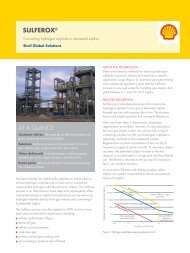ENVIRONMENTAL STATEMENT BARDOLINO DEVELOPMENT
ENVIRONMENTAL STATEMENT BARDOLINO DEVELOPMENT
ENVIRONMENTAL STATEMENT BARDOLINO DEVELOPMENT
Create successful ePaper yourself
Turn your PDF publications into a flip-book with our unique Google optimized e-Paper software.
Bardolino Development Environmental Statement<br />
During 1986, the whole of the North Sea was surveyed using standard techniques and<br />
equipment (Künitzer et al., 1992). This survey identified and classified different species<br />
distributions and assemblages of benthic fauna in relation to factors such as latitude,<br />
temperature, water depth and sediment type. Based on the findings of this survey, the<br />
benthic communities in the proposed Bardolino development area would be expected to be<br />
characteristic of the deep-water infaunal assemblage, which typically has high densities<br />
(2,863±1,844 individuals per m 2 ) and species richness (51±13 species) (Künitzer et al., 1992).<br />
Indicator species of this benthic infaunal assemblage include the Thyasira sp. bivalve<br />
complex and the polychaetes Minuspio cirrifera, Aricidea catherinae and Exogone verugera<br />
(Künitzer et al., 1992). Epifauna species identified in the area include the starfish Astropecten<br />
irregularis and Asterias rubens, the echinoid Echinocardium flavescens, the gastropods<br />
Neptunea antique, Colus gracilis and Scaphander lignarius, tunicates and sponges (Basford<br />
et al., 1989).<br />
Benthic faunal analysis was undertaken as part of the Nelson field seabed survey undertaken<br />
in 2005 and 2006 (Section 4.2.6). A total of 204 species was identified from the 12,055<br />
individuals recovered from a total of 18 samples. The seabed area more than 500 m from the<br />
Nelson platform was found to be dominated by the polychaetes Paramphiome jeffreysii,<br />
Myriochele sp. A., Exogone hebes and the brittle star Ophiura affinis (Hartley Anderson,<br />
2007). Within 500 m of the Nelson platform the dominant species were the polychaetes<br />
Chaetozone setosa and Paramphiome jeffreysii (Hartley Anderson, 2007).<br />
Paramphiome jeffreysii, present in high numbers at all stations sampled, is an opportunistic<br />
colonising polychaete, characteristic of deep, offshore, cohesive sandy mud. This polychaete<br />
is common throughout the North Sea in similar habitats and is frequently recorded in the<br />
vicinity of offshore platforms.<br />
Thyasira sp and Chaetozone setosa were present in large numbers at Station Nel-01, 200 m<br />
from the platform. These species are known to be indicative of elevated hydrocarbon<br />
concentrations in offshore sediments. C. setosa, in particular, is well adapted to colonise and<br />
exploit disturbed and organically enriched habitats. It is a secondary coloniser, able to move<br />
into areas once conditions are favourable enough for it to out-compete the primary colonisers<br />
such as Raricirrus beryli and Capitella capitata (ERT, 2000). Raricirrus beryli was not present<br />
at any of the stations sampled in the 2007 Nelson survey and Capitella capitata was only<br />
present at station Nel-01 in very small numbers (7 indiviuals identified in 3 samples). This<br />
indicates that the sediment in the immediate vicinity of the Nelson platform (200 m) is now<br />
recovering from previous hydrocarbon pollution. Table 4.11 lists the ten dominant species<br />
identified at each of the six sample stations.<br />
April 2008 Page 4-21


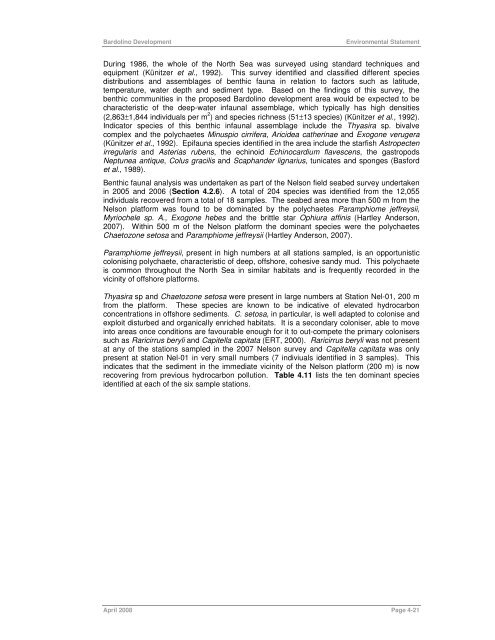

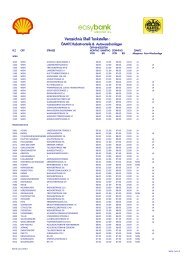
![Download Shell AutoGas Stationen [Stand: Januar 2013] (PDF](https://img.yumpu.com/9982753/1/190x245/download-shell-autogas-stationen-stand-januar-2013-pdf.jpg?quality=85)
